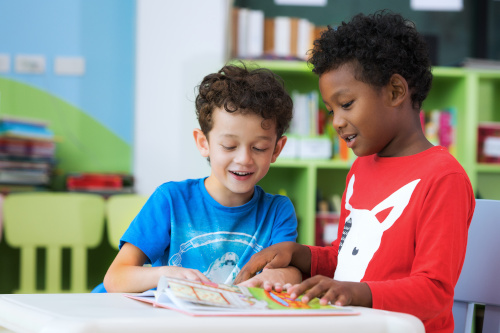Learning to read is a higher brain function. Reading comprehension activates the cerebral cortex of a child’s brain. This part of the brain is important for complex cognitive tasks, but it’s also the part of the brain that’s the most sensitive to the harmful effects of stress.
Because stress impairs both learning and memory, teachers can improve reading comprehension and enhance classroom learning by reducing student stress through positive psychology.
The psychology of happiness and learning
While stress disrupts the brain’s learning processes, a positive mood has the opposite effect. Cultivating a positive emotional state helps to reduce the harmful effects of stress and even improves cognitive function. Author and psychology expert Shawn Achor, who has conducted extensive research on positive intelligence, cites several examples in his best-selling book The Happiness Advantage. For example, in intelligence tests, being in a positive mood increased exam takers’ intelligence and creativity.
The effects are complex, but the rationale is straightforward. Positive emotions trigger the release of neurotransmitters (such as serotonin, oxytocin, and dopamine), and these brain chemicals help activate the learning centers of the brain. As a teacher, this was incredibly eye-opening for me. Many educators focus on classroom tools and teaching techniques, but this research shows that one of the most powerful things you can do is prime your students’ brains with positivity.
Positive psychology starts with SMILES
There are dozens of empirical studies on mood and cognition. Without getting too deep into the proverbial weeds, you can use six basic positive psychology strategies in your classroom to better support stressed-out students and improve their reading comprehension and learning.
The acronym SMILES can help you get started. Here’s a breakdown of what it means.
1. Shared Gratitude
Experiencing gratitude changes the brain’s structure, raises your students’ sense of happiness and pleasure, and reduces their level of cortisol (the stress hormone linked with impaired cognition and learning difficulties). Find ways to incorporate a routine of thankfulness in your classroom. For instance, after reading a book about a famous person from history, you could ask the class to share why they’re thankful for this individual.
2. Meditation
Being more mindful reduces stress and promotes positive emotions. In many classrooms, students rush in and immediately get into their coursework and lessons. Try starting each class with a brief moment of meditation and mindfulness. Students of all ages can sit for a minute or two while you (or an app or audiobook) guide them through a few quick breathing exercises and a moment of calm.
3. Intentional kindness
Decades of research have revealed that being intentionally kind boosts your mood. Invite your class to consider ways to be kind, and find ways to weave kindness and giving back into your curriculum. For example, your students could help pick up trash in the schoolyard, write letters to cheer up frontline healthcare workers, or fundraise for a local animal shelter. Try to find a way to give back that relates to your reading curriculum’s seasonal topics.
4. Looking back with thankfulness
Self-reflection, or looking back at past positive experiences, primes the brain for positivity. You can use worksheets or verbal questions to create an opportunity for each student to think back on a recent experience they’re thankful for. This could be something that happened at school or in their personal lives.
5. Exercise
Physical movement triggers the release of feel-good, cognition-enhancing neurotransmitters within five minutes. It’s also a powerful way to help your students burn off fidgety energy (thus improving focus and attention). Before jumping into a reading lesson or giving an exam, give the kids a chance to move their bodies. It could be something as simple as a game of tag, or something that relates to their academics, such as acting out a scene from a book they’ve been reading.
6. Social connection
Social connectedness improves mood and overall life satisfaction. Create opportunities for students to connect on a social level within your classroom. For example, they can take turns sharing about their background and life or bring snacks or objects from their own lives that represent their connection to a certain lesson.
Incorporating elements of positive psychology into your classroom teaching can feel foreign at first. But teachers who invest in their students’ mood and positivity, and who use the above psychological principles to reduce student stress and tension, will see dramatic results in their classroom’s academics and reading comprehension. You may even be tempted to apply these same principles to your own life to build your own stress resilience and overall sense of joy and happiness.
- 3 ways to avoid summer learning loss - April 19, 2024
- High school students say AI will change the workforce - April 18, 2024
- Motivating students using the Self-Determination Theory - April 17, 2024


